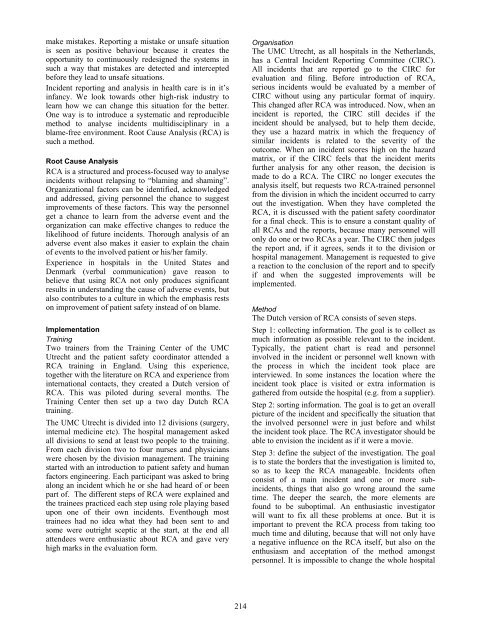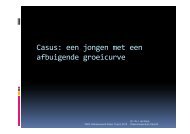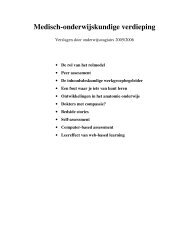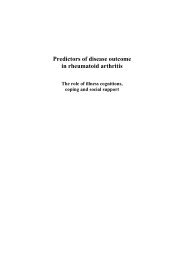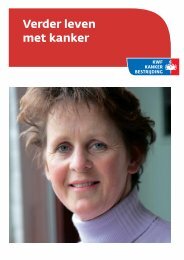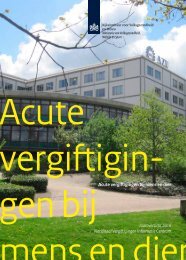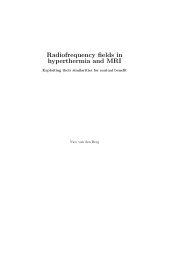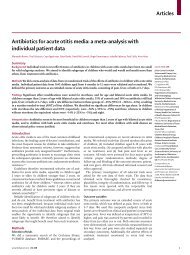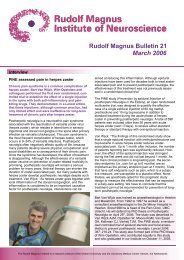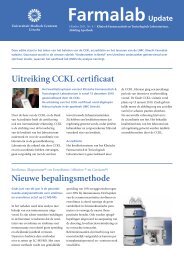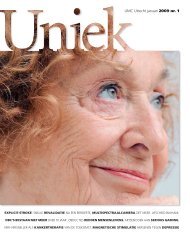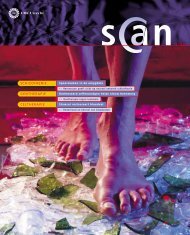System-based risk analysis in healthcare
System-based risk analysis in healthcare
System-based risk analysis in healthcare
You also want an ePaper? Increase the reach of your titles
YUMPU automatically turns print PDFs into web optimized ePapers that Google loves.
make mistakes. Report<strong>in</strong>g a mistake or unsafe situation<br />
is seen as positive behaviour because it creates the<br />
opportunity to cont<strong>in</strong>uously redesigned the systems <strong>in</strong><br />
such a way that mistakes are detected and <strong>in</strong>tercepted<br />
before they lead to unsafe situations.<br />
Incident report<strong>in</strong>g and <strong>analysis</strong> <strong>in</strong> health care is <strong>in</strong> it’s<br />
<strong>in</strong>fancy. We look towards other high-<strong>risk</strong> <strong>in</strong>dustry to<br />
learn how we can change this situation for the better.<br />
One way is to <strong>in</strong>troduce a systematic and reproducible<br />
method to analyse <strong>in</strong>cidents multidiscipl<strong>in</strong>ary <strong>in</strong> a<br />
blame-free environment. Root Cause Analysis (RCA) is<br />
such a method.<br />
Root Cause Analysis<br />
RCA is a structured and process-focused way to analyse<br />
<strong>in</strong>cidents without relaps<strong>in</strong>g to “blam<strong>in</strong>g and sham<strong>in</strong>g”.<br />
Organizational factors can be identified, acknowledged<br />
and addressed, giv<strong>in</strong>g personnel the chance to suggest<br />
improvements of these factors. This way the personnel<br />
get a chance to learn from the adverse event and the<br />
organization can make effective changes to reduce the<br />
likelihood of future <strong>in</strong>cidents. Thorough <strong>analysis</strong> of an<br />
adverse event also makes it easier to expla<strong>in</strong> the cha<strong>in</strong><br />
of events to the <strong>in</strong>volved patient or his/her family.<br />
Experience <strong>in</strong> hospitals <strong>in</strong> the United States and<br />
Denmark (verbal communication) gave reason to<br />
believe that us<strong>in</strong>g RCA not only produces significant<br />
results <strong>in</strong> understand<strong>in</strong>g the cause of adverse events, but<br />
also contributes to a culture <strong>in</strong> which the emphasis rests<br />
on improvement of patient safety <strong>in</strong>stead of on blame.<br />
Implementation<br />
Tra<strong>in</strong><strong>in</strong>g<br />
Two tra<strong>in</strong>ers from the Tra<strong>in</strong><strong>in</strong>g Center of the UMC<br />
Utrecht and the patient safety coord<strong>in</strong>ator attended a<br />
RCA tra<strong>in</strong><strong>in</strong>g <strong>in</strong> England. Us<strong>in</strong>g this experience,<br />
together with the literature on RCA and experience from<br />
<strong>in</strong>ternational contacts, they created a Dutch version of<br />
RCA. This was piloted dur<strong>in</strong>g several months. The<br />
Tra<strong>in</strong><strong>in</strong>g Center then set up a two day Dutch RCA<br />
tra<strong>in</strong><strong>in</strong>g.<br />
The UMC Utrecht is divided <strong>in</strong>to 12 divisions (surgery,<br />
<strong>in</strong>ternal medic<strong>in</strong>e etc). The hospital management asked<br />
all divisions to send at least two people to the tra<strong>in</strong><strong>in</strong>g.<br />
From each division two to four nurses and physicians<br />
were chosen by the division management. The tra<strong>in</strong><strong>in</strong>g<br />
started with an <strong>in</strong>troduction to patient safety and human<br />
factors eng<strong>in</strong>eer<strong>in</strong>g. Each participant was asked to br<strong>in</strong>g<br />
along an <strong>in</strong>cident which he or she had heard of or been<br />
part of. The different steps of RCA were expla<strong>in</strong>ed and<br />
the tra<strong>in</strong>ees practiced each step us<strong>in</strong>g role play<strong>in</strong>g <strong>based</strong><br />
upon one of their own <strong>in</strong>cidents. Eventhough most<br />
tra<strong>in</strong>ees had no idea what they had been sent to and<br />
some were outright sceptic at the start, at the end all<br />
attendees were enthusiastic about RCA and gave very<br />
high marks <strong>in</strong> the evaluation form.<br />
Organisation<br />
The UMC Utrecht, as all hospitals <strong>in</strong> the Netherlands,<br />
has a Central Incident Report<strong>in</strong>g Committee (CIRC).<br />
All <strong>in</strong>cidents that are reported go to the CIRC for<br />
evaluation and fil<strong>in</strong>g. Before <strong>in</strong>troduction of RCA,<br />
serious <strong>in</strong>cidents would be evaluated by a member of<br />
CIRC without us<strong>in</strong>g any particular format of <strong>in</strong>quiry.<br />
This changed after RCA was <strong>in</strong>troduced. Now, when an<br />
<strong>in</strong>cident is reported, the CIRC still decides if the<br />
<strong>in</strong>cident should be analysed, but to help them decide,<br />
they use a hazard matrix <strong>in</strong> which the frequency of<br />
similar <strong>in</strong>cidents is related to the severity of the<br />
outcome. When an <strong>in</strong>cident scores high on the hazard<br />
matrix, or if the CIRC feels that the <strong>in</strong>cident merits<br />
further <strong>analysis</strong> for any other reason, the decision is<br />
made to do a RCA. The CIRC no longer executes the<br />
<strong>analysis</strong> itself, but requests two RCA-tra<strong>in</strong>ed personnel<br />
from the division <strong>in</strong> which the <strong>in</strong>cident occurred to carry<br />
out the <strong>in</strong>vestigation. When they have completed the<br />
RCA, it is discussed with the patient safety coord<strong>in</strong>ator<br />
for a f<strong>in</strong>al check. This is to ensure a constant quality of<br />
all RCAs and the reports, because many personnel will<br />
only do one or two RCAs a year. The CIRC then judges<br />
the report and, if it agrees, sends it to the division or<br />
hospital management. Management is requested to give<br />
a reaction to the conclusion of the report and to specify<br />
if and when the suggested improvements will be<br />
implemented.<br />
Method<br />
The Dutch version of RCA consists of seven steps.<br />
Step 1: collect<strong>in</strong>g <strong>in</strong>formation. The goal is to collect as<br />
much <strong>in</strong>formation as possible relevant to the <strong>in</strong>cident.<br />
Typically, the patient chart is read and personnel<br />
<strong>in</strong>volved <strong>in</strong> the <strong>in</strong>cident or personnel well known with<br />
the process <strong>in</strong> which the <strong>in</strong>cident took place are<br />
<strong>in</strong>terviewed. In some <strong>in</strong>stances the location where the<br />
<strong>in</strong>cident took place is visited or extra <strong>in</strong>formation is<br />
gathered from outside the hospital (e.g. from a supplier).<br />
Step 2: sort<strong>in</strong>g <strong>in</strong>formation. The goal is to get an overall<br />
picture of the <strong>in</strong>cident and specifically the situation that<br />
the <strong>in</strong>volved personnel were <strong>in</strong> just before and whilst<br />
the <strong>in</strong>cident took place. The RCA <strong>in</strong>vestigator should be<br />
able to envision the <strong>in</strong>cident as if it were a movie.<br />
Step 3: def<strong>in</strong>e the subject of the <strong>in</strong>vestigation. The goal<br />
is to state the borders that the <strong>in</strong>vestigation is limited to,<br />
so as to keep the RCA manageable. Incidents often<br />
consist of a ma<strong>in</strong> <strong>in</strong>cident and one or more sub<strong>in</strong>cidents,<br />
th<strong>in</strong>gs that also go wrong around the same<br />
time. The deeper the search, the more elements are<br />
found to be suboptimal. An enthusiastic <strong>in</strong>vestigator<br />
will want to fix all these problems at once. But it is<br />
important to prevent the RCA process from tak<strong>in</strong>g too<br />
much time and dilut<strong>in</strong>g, because that will not only have<br />
a negative <strong>in</strong>fluence on the RCA itself, but also on the<br />
enthusiasm and acceptation of the method amongst<br />
personnel. It is impossible to change the whole hospital<br />
214


